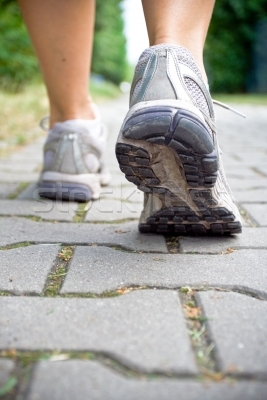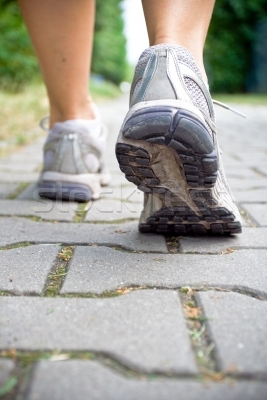
Optimizing Movement Efficiency in an Unnatural Environment
As we begin another year, 2015 shows promising growth for the barefoot movement within the health & fitness industry. With an increase in barefoot-only training facilities, athletes prepping barefoot and even top educators touting the benefits of barefoot training we must remind ourselves – why barefoot?l And can these benefits exceed the athlete or the rehabbing client?
Yes barefoot is more “natural’ but if we live in a shod society and spend out days pounding the pavement- do the benefits of barefoot training exceed the gym and training facility?
I am faced with this question often as I continuously promote barefoot activation and barefoot rehab to my patients and in my education. I often ask myself – what is my ultimate goal by building this barefoot awareness?
Will we all eventually opt for a barefoot lifestyle? Hardly.
Living in an Unnatural Environment
As we embrace this increased awareness towards the importance of feet, footwear, and barefoot training we must also remember that we live in a shod society, surrounded by a concrete jungle gym.
How can we begin to apply the benefits of barefoot training beyond that of fitness, performance and rehab? The answer to this question has to do with the concept of movement efficiency. It is my goal to teach my patients how to restore their innate relationship with the ground on which they walk – thereby improving their ability to load and unload impact forces with each step.
This natural ability to load and unload impact forces is referred to ask movement efficiency and really is my ultimate goal with my patients. By improving movement efficiency we decreased our risk of injury while optimizing our performance – both of which translates to enhancing our ability to do the things we enjoy to do.
To use barefoot training principles to optimize movement efficiency we must understand the following concepts:
1st – The human body was designed to move with the energy provided from impact forces.
With each step we take the body encounters between 1 – 1.5 x our body weight in ground reaction forces. These impact forces are a necessary component to the energy we use take the next step.
Acting as potential and elastic energy, proper loading and unloading of impact forces (energy) allows us to move with the grace of a dancer and the speed of an athlete. When we begin to lose this relationships with impact forces, movement which is often taken for granted (i.e. walking) becomes work.
2nd – The foot plays a critical role in how we respond to impact forces.
It is actually pre-programmed into our nervous (and fascial) system to load / unload the energy – from the ground up. Starting with stimulation of the plantar foot, thousands of small mechanoceptors respond to the vibration created by impact forces.
Stimulation of the plantar skin leads to a subsequent activation of the small muscles in the foot, which act as splints protecting the long bones of the foot (metatarsals). Directly following (or rather simultaneously) this intrinsic muscle contraction leads to co-activation of the proximal (hip) stabilizers which further controls deceleration and loading.
A delay in the from the ground up loading mechanism is often associated with overuse injury such as shin splints Achilles tendonitis, patellofemoral pain, ITB syndrome plus more.
3rd – Unnatural Surfaces Impair Efficient Movement
All surfaces provide a certain frequency of vibrations (impact forces) when contacted by the foot. With the optimal frequency lying within 15 – 20 Hz our neuromuscular system is designed to create a reflexive response to this input. Remembering that vibrations provide the energy we need to take the next step, our ability to match this ideal frequency is important.
Certain surfaces such as concrete or marble do not transmit vibrations well. Impact on these unnatural surfaces still in present but instead of it transmitting through the surface and the body – all of the forces transmit proximally through the body. These increase in impact forces alters the vibration frequency and thereby alters the timing of the loading response.
The more we continue to alter the input encountered by the body, the greater the risk of injury with the most common being stress fractures.
4th – Footwear further alters the Perception of Impact Forces
Not only does today’s society require movement on unforgiving, unnatural surfaces but it must also be done in shoes. Footwear blocks our perception of impact force vibration frequency, creating a complete disassociation from the ground on which we walk.
If we do not continuously tap into our innate loading response and plantar foot stimulation, we are setting ourselves up for continued risk of injury.
I have build a program which I teach my patients how to keep the plantar foot strong and neuromuscular responses sharp. I call this the BarefootRx Program.
1. Keep the feet strong.
18 muscles in the bottom of the foot designed to contract against the impact forces of each step. My go-to exercise for foot strengthening is short foot. If short foot is not your cup of tea simply balance on one leg (barefoot) will begin to activate the intrinsics of the foot.
Recommended: Short foot activation daily (preferably morning) and before working out
2. Keep the feet flexible.
To have flexible feet means that you are allowing the foot to dance between laoding and unloading with each step we take. Note that flexible does not mean unstable, so having a flat foot isn’t an advantage in this concept.
My go-to exercise for flexible feet is to stand on golf balls or a lacrosse ball. There are a variety of products now on the market which are designed for plantar foot release. I am not partial to any as long as you are releasing your foot.
Recommended: Plantar foot release every day 5 min (morning & evening) and before working out
3. Foot to core integration.
Since the body (and our loading response) is integrated between the foot and proximal core / hip integration is key to optimal movement efficiency. Here barefoot balancing is my go-to exercise. Through progressive barefoot balance exercises with short foot one is able to restore and promote foot to core stabilizing patterns.
Recommended: Barefoot balance training integrating short foot 3 x week 30 minutes
To learn more about movement efficiency, barefoot training and injury prevention please stay tuned for Dr Emily’s new book coming out February 2015:
BAREFOOT STRONG: Unlock the Secrets to Movement Longevity www.barefootstrong.com

